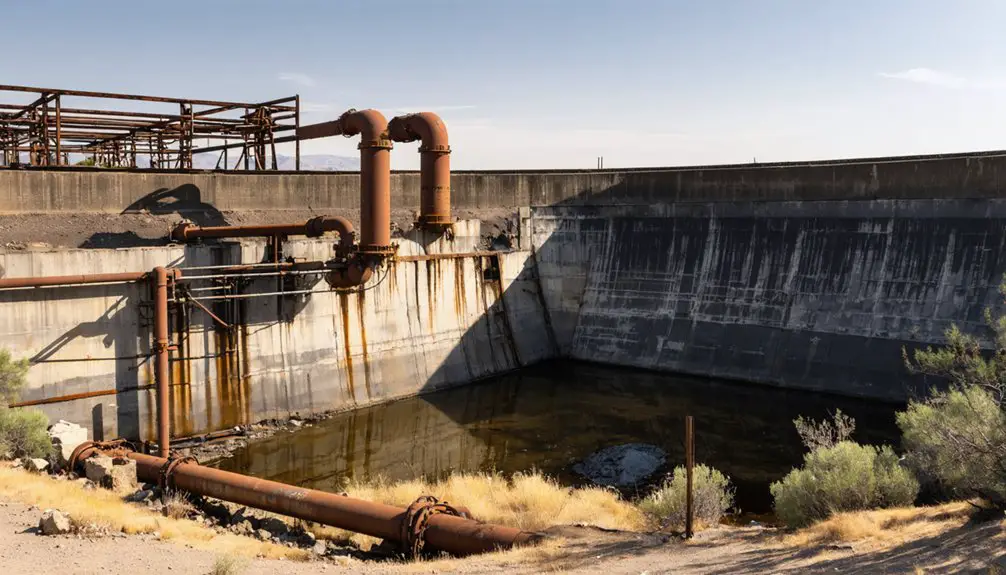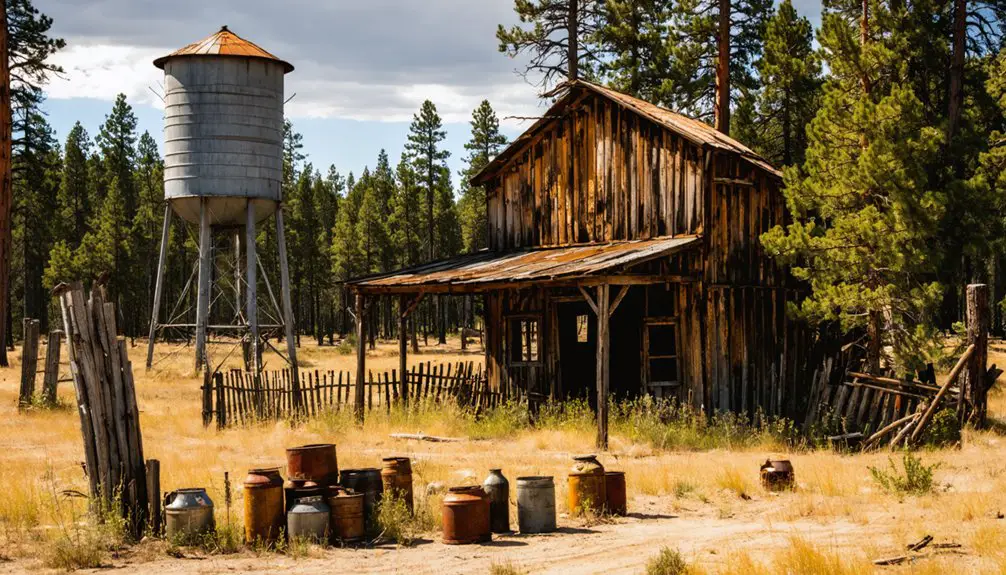You’ll find Sparta, Oregon’s remains in the northeastern part of the state, where gold was discovered in the Eagle Creek region in the late 1860s. The town boomed after 1871 when the 32-mile Sparta Ditch brought essential water to the placer mines, growing to 5,000 miners at its peak. Chinese immigrants formed a vibrant community here until declining gold yields led to the town’s abandonment. Today, Heilner’s 1872 store and traces of the historic ditch reveal Sparta’s golden past.
Key Takeaways
- Sparta was a thriving Oregon gold mining town established around 1870, which reached a peak population of 5,000 during its heyday.
- The town’s success depended on the 32-mile Sparta Ditch irrigation system, built by Chinese laborers to support mining operations.
- A diverse community featured a large Chinatown of over 1,000 residents, complete with temples, stores, and gambling establishments.
- The town declined as placer gold profits diminished, with the post office closing in 1952, marking its transition to ghost town status.
- Today, only Sigmund Heilner’s 1872 store, traces of the Sparta Ditch, and a Chinese cemetery remain as historical remnants.
The Birth and Early Days of a Mining Frontier
While gold deposits had been discovered in northeastern Oregon’s Eagle Creek region, the lack of water initially prevented miners from extracting the precious metal from Sparta’s placer fields.
You’ll find the town’s establishment was the result of careful planning led by Baker City investor William H. Packwood, who focused on solving the water scarcity problem.
By 1869, the Eagle Canal Company formed to evaluate mining ditch possibilities. The area, previously known as Koster, Eagle City, and Gem, became officially named Sparta around 1870-1871, after Packwood’s Illinois hometown.
The Eagle Canal Company’s formation in 1869 led to Sparta’s official naming, reflecting Packwood’s roots in Illinois.
The town’s strategic location near key gulches, combined with significant labor contributions from Chinese workers under Ah Fat and Le Tew, transformed the site into a thriving mining settlement of 1,000-1,200 residents by the late 1870s. The Sparta Ditch’s 32 miles of waterway construction proved crucial for accessing the region’s rich placer gold deposits. The Chinese community established a vibrant cultural district that included stores, a temple, and various businesses.
Gold Rush Glory: Peak Mining Years
The completion of Sparta’s water infrastructure in 1871 launched the town into its most productive era of gold mining. The 32-mile Sparta Ditch transformed the region’s mining capabilities, enabling extensive hydraulic operations that would yield hundreds of thousands in gold profits.
Chinese immigration surged during this period, with labor contracts bringing up to 1,200 Chinese workers through specialized China Companies. The Powder River Basin formed a dramatic backdrop to the mining operations. Early diggings in the area produced hundreds of thousands in valuable nuggets.
- Lode mines generated $677,000 in gold production
- A thriving Chinatown emerged with temples and services
- Three major stores operated alongside gambling halls
- The Eagle Canal Company financed key infrastructure
You’d have found a bustling frontier town during these peak years, with mining profits fueling local commerce.
The multicultural workforce shaped Sparta’s character, creating a vibrant community centered around gold extraction and the promise of prosperity.
Water Management and Infrastructure Development

Building Sparta’s massive 32-mile irrigation ditch in 1871 marked a turning point for this gold mining settlement‘s development.
William H. Packwood and the Eagle Canal Company tackled irrigation challenges head-on, employing Chinese laborers under supervisors Ah Fat and Le Tew to construct this essential waterway. Their water conservation efforts transformed previously unworkable claims at Rattlesnake Gulch and Eagle Creek into productive mining operations.
The ditch’s completion spurred rapid infrastructure growth, with the town soon boasting three stores, hotels, a drugstore, saloons, and a post office. Like the historic town of Granite, this settlement reached a peak population of five thousand miners during its heyday.
You’ll find the settlement’s layout was strategically planned around water access, supporting both mining operations and community needs. The town originally went through several names including Koster and Eagle City before settling on Sparta.
While the ditch stands today as a symbol of 19th-century engineering, mining declined by 1915 as gold resources depleted.
From Boom to Bust: The Town’s Transformation
Sparta’s rapid growth after 1870 showcased the classic trajectory of Western mining boomtowns, as the settlement swelled to 300 residents by 1873.
Like many Western boomtowns, Sparta transformed from a humble outpost to a bustling settlement of 300 souls within three years.
You’d have witnessed remarkable cultural diversity, with a thriving Chinatown housing over 1,000 Chinese residents by the late 1870s, complete with stores, temples, and social services.
Like ancient Sparta’s dual kingship system, the town maintained a complex governance structure with multiple decision-makers overseeing mining operations and water rights.
Similar to Auburn’s first gold rush discovery in eastern Oregon, the town attracted scores of prospectors seeking fortune.
The town’s transformation from boom to bust followed these key phases:
- Peak prosperity with multiple businesses serving miners and workers
- Gradual decline as placer gold deposits became less profitable
- Deterioration of the vital Sparta Ditch water system
- Final exodus leading to ghost town status by mid-20th century
Economic challenges intensified as water access dwindled, ultimately forcing the closure of the post office in 1952 and marking Sparta’s complete transformation into a ghost town.
Historic Remnants and Legacy Today
While most of Sparta’s original structures have vanished into history, you’ll still find Sigmund Heilner’s 1872 general goods store standing as one of the last tangible links to this once-bustling mining town.
The landscape now holds mostly rubble and foundations, though you can trace remnants of the historic Sparta Ditch, a 32-mile engineering marvel built by Chinese laborers in 1871. The town’s hard rock mining operations ceased completely by 1915, marking the end of its primary economic activity.
A Chinese cemetery near the townsite serves as a poignant reminder of the town’s cultural heritage, with visible burial pits marking where remains once rested before their repatriation to China.
The ditch, which later shifted from mining to agricultural use, stands as a monument to historic preservation efforts and the significant contributions of Chinese immigrants who shaped Sparta’s development through their labor and community presence.
Frequently Asked Questions
Are There Any Paranormal Activities Reported in Sparta’s Abandoned Buildings?
Unlike Oregon’s 79 documented haunted locations, you won’t find credible ghost sightings in Sparta’s abandoned buildings. No paranormal activities have been officially reported at these remote haunted locations.
Can Visitors Legally Collect Artifacts or Gold From the Old Mine Sites?
You can’t legally collect artifacts or gold without proper permits and landowner permission. Mining regulations protect historic sites, and artifact preservation laws safeguard cultural resources on both public and private lands.
What Are the Best Seasons and Road Conditions for Visiting Sparta?
Are you ready to step back in time? You’ll find the best visiting conditions in early May or fall, when roads are dry and stable. Pack offline maps—you’re facing gravel switchbacks and limited cell service.
Are There Guided Tours or Organized Historical Excursions to Sparta?
You won’t find organized guided tours or historical excursions to Sparta. You’ll need to explore independently, using road trip guides and maps to discover this remote ghost town on your own terms.
How Dangerous Are the Remaining Mine Shafts and Tunnels Today?
You’re playing with fire – mine shaft safety is nonexistent with unstable supports, deep drops, and flooding hazards. Tunnel exploration risks include cave-ins, toxic gases, and contaminated water that could trap you.
References
- https://traveloregon.com/things-to-do/culture-history/ghost-towns/sparta/
- https://accessgenealogy.com/oregon/sparta-cemetery-sparta-oregon.htm
- https://westernmininghistory.com/towns/oregon/sparta/
- https://en.wikipedia.org/wiki/Sparta
- https://en.wikipedia.org/wiki/List_of_ghost_towns_in_Oregon
- https://www.oregonencyclopedia.org/articles/sparta_ditch/
- https://www.oregonencyclopedia.org/articles/?i=&page=2&q=&q=Chinese
- https://www.oregon.gov/dogami/milo/archive/MiningDistricts/BakerCounty/SpartaDistrict/SpartaMiscDocs/SpartaMiscDocsReports.pdf
- https://dirtyfreehub.org/routes/oregon/sparta/
- http://nevada-outback-gems.com/Gold_rush_history/Oregon/Oregon05.htm



